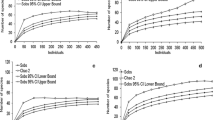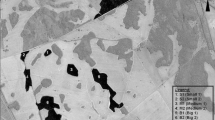Abstract
In African cocoa agroforestry systems, ants represent the most important part of arboreal arthropod biomass and play a crucial role in ecosystem functioning. The more abundant are supposed to be involved in crop pest regulation. However, the lack of knowledge about ecological interactions between ants and their habitat, including other ant species of the community, leaded to contradictory views on their efficiency as potential biological control agents. In the present study, we studied the impact of shade trees on the occurrence and spatial distribution of the most abundant ants of cocoa agroforestry systems of Southern Cameroon. We characterized shade of four traditional cocoa farms and described distribution patterns of numerically dominant ants through spatial analysis. Our results showed that the populations of the most abundant arboreal species, in our study Oecophylla longinoda, Tetramorium aculeatum, Crematogaster spp., Camponotus spp. were generally aggregated in plantations. However, the distribution structure of ant populations was variable between samples, suggesting that the normal development of ant colonies may interfere with ecological constraints like interspecific competition and abiotic factors. Distribution mapping as well as statistical analysis showed that highest densities of O. longinoda were sheltered by cocoa trees in the sunniest areas of plots. On the other hand, Crematogaster species were usually strongly aggregated in the most shaded areas. Mechanisms involved in ant/shade relationships were discussed and we suggested that a good management of shade may take into account ant communities, which could play a significant role in conservation biological control against cocoa pests.





Similar content being viewed by others
References
Anikwe JC, Omoloye AA, Aikpokpodion PO, Okelana FA, Eskes AB (2009) Evaluation of resistance in selected cocoa genotypes to the brown cocoa mirid, Sahlbergella singularis Haglund in Nigeria. Crop Prot 28:350–355
Anscombe FJ (1949) The statistical analysis of insect counts based on the negative binomial distribution. Biometrics 5:165–173
Armbrecht I, Jiménez E, Alvarez G, Ulloa-Chacon P, Armbrecht H (2001) An ant mosaic in the Colombian rain forest of Chocco (Hymenoptera: Formicidae). Sociobiology 37:491–509
Avelino J, ten Hoopen GM, DeClerck AJF (2011) Ecological mechanisms for pest and disease control in coffee and cacao agroecosystems of the neotropics. In: Rapidel B, Lecoq JF, Beer J (eds) Ecosystem services from agriculture and agroforestry: measurement and payment. Earthscan, London, pp 91–117
Babin R (2009) Contribution à l’amélioration de la lutte contre le miride du cacaoyer Sahlbergella singularis Hagl. (Hemiptera : Miridae). Influence des facteurs agro-écologiques sur la dynamique des populations du ravageur. Doctorate Thesis, Université de Montpellier III, France
Babin R, ten Hoopen GM, Cilas C, Enjalric F, Yede, Gendre P, Lumaret JP (2010) Impact of shade on the spatial distribution of Sahlbergella singularis in traditional cocoa agroforests. Agric For Entomol 12:69–79
Babin R, Anikwe JC, Dibog L, Lumaret J-P (2011) Effects of cocoa tree phenology and canopy microclimate on the performance of the mirid bug Sahlbergella singularis. Entomol Exp Appl 141:25–34
Bellow JG, Nair PKR (2003) Comparing common methods for assessing understory light availability in shaded-perennial agroforestry systems. Agr For Meteorol 114:197–211
Bigger M (1981) Observations on the insect fauna of shaded and unshaded Amelonado cocoa. B Entomol Res 71:107–119
Bisseleua BD, Vidal S (2008) Plant biodiversity and vegetation structure in traditional cocoa forest gardens in southern Cameroon under different management. Biodivers Conserv 17:1821–1835
Bolton B (1994) Identification guide to the ant genera of the world. Harvard University Press, Cambridge
Cammaerts R, Cammaerts MC, Dejean A (1994) The trail of the African urticating ant, Tetramorium aculeatum: source, potency, and workers’ behavior (Hymenoptera: Formicidae). J Insect Behav 7:533–552
Collingwood CA (1977) Biological control and relations with other insects. In: Lavabre EM (ed) Les Mirides du Cacaoyer. G-P Maisonneuve et Larose, Paris, pp 237–255
Davidson DW (1998) Resource discovery versus resource domination in ants: a functional mechanism for breaking the trade-off. Ecol Entomol 23:484–490
de la Mora A, Livingston G, Philpott SM (2008) Arboreal ant abundance and leaf miner damage in coffee agroecosystems in Mexico. Biotropica 40:742–746
Dejean A, Corbara B, Orivel J, Leponce M (2007) Rainforest canopy ants: the implications of territoriality and predatory behavior. Funct Ecosyst Commun 1:105–120
Dejean A, Djiéto-Lordon C, Céréghino R, Leponce M (2008) Ontogenetic succession and the ant mosaic: An empirical approach using pioneer trees. Basic Appl Ecol 9:316–323
Djiéto-Lordon C, Dejean A (1999) Tropical arboreal ant mosaics: innate attraction and imprinting determine nest site selection in dominant ants. Behav Ecol Sociobiol 45:219–225
Djiéto-Lordon C, Richard FJ, Owona C, Giberneau M, Orivel J, Dejean A (2001) The predatory behavior of the dominant arboreal ant species Tetramorium aculeatum (Hymenoptera: Formicidae). Sociobiology 38:765–775
Entwistle PF (1972) Pests of cocoa. Longman Group Limited, London
Frazer GW, Canham CD, Lertzman KP (1999) Gap Light Analyzer (GLA), Version 2.0: Imaging software to extract canopy structure and gap light transmission indices from true-colour fisheye photographs, user’s manual and program documentation. Simon Fraser University, Burnaby, British Columbia, and the Institute of Ecosystem Studies, Millbrook, New York
Hölldobler B, Wilson EO (1978) Multiple recruitment systems of African weaver ant Oecophylla longinoda (Latreille) (Hymenoptera Formicidae). Behav Ecol Sociobiol 3:19–60
Hölldobler B, Wilson EO (1990) The Ants. The Belknap of Harvard University Press, Cambridge
Hooks CRR, Fereres A (2006) Protecting crops from non-persistently aphid-transmitted viruses: A review on the use of barrier plants as a management tool. Virus Res 120:1–16
Isaac ME, Timmer VR, Quashie-Sam SJ (2007) Shade tree effects in an 8-year-old cocoa agroforestry system: biomass and nutrient diagnosis of Theobroma cacao by vector analysis. Nutr Cycl Agroecosyst 78:155–165
Leston D (1973) The ant mosaic-tropical tree crops and the limiting of pest and diseases. Pans 19:311–339
Majer JD (1976) The ant mosaic in Ghana cocoa farms: further structural considerations. J Appl Ecol 13:145–155
Majer JD (1992) Comparison of the arboreal ant mosaic in Ghana, Brazil, Papua New Guinea and Australia—its structure and influence on arthropod diversity. In: Gauld LA (ed) Hymenoptera and Biodiversity. CAB International, Wallingford, pp 115–141
Majer JD, Delabie JHC, Smith MRB (1994) Arboreal ant community patterns in Brazilian cocoa farms. Biotropica 26:73–83
Mouen Bedimo JA, Njiayouom I, Bieysse D, Nkeng MN, Cilas C, Notteghem JL (2008) Effect of shade on Arabica coffee berry disease development: toward an agroforestry system to reduce disease impact. Phytopathology 98:1320–1325
Perfecto I, Vandermeer JH, Lopez BG, Ibarra NG, Greenberg R, Bichier P, Langridge S (2004) Greater predation in shaded coffee farms: the role of resident neotropical birds. Ecology 85:2677–2681
Philpott SM (2006) Ant patchiness: a spatially quantitative test in coffee agroecosystems. Naturwissenschaften 93:386–392
Philpott SM, Armbrecht I (2006) Biodiversity in tropical agroforests and the ecological role of ants and ant diversity in predatory function. Ecol Entomol 31:369–377
Philpott SM, Perfecto I, Vandermeer J (2008) Behavioral diversity of predatory arboreal ants in coffee agroecosystems. Environ Entomol 37:181–191
Ratnadass A, Fernandes P, Avelino J, Habib R (2012) Plant species diversity for sustainable management of crop pests and diseases in agroecosystems: a review. Agron Sustainable Dev 32:273–303
Richard FJ, Fabre A, Dejean A (2001) Predatory behavior in dominant arboreal ant species: the case of Crematogaster sp. (Hymenoptera: Formicidae). J Insect Behav 14:271–282
Room PM (1975) Relative distributions of ant species in cocoa plantations in Papua New Guinea. J Appl Ecol 17:47–61
Seguni ZSK, Way MJ, Van Mele P (2011) The effect of ground vegetation management on competition between the ants Oecophylla longinoda and Pheidole megacephala and implications for conservation biological control. Crop Prot 30:713–717
Sonwa DJ, Nkongmeneck BA, Weise S, Tchatat M, Adesina A, Janssens MJJ (2007) Diversity of plants in cocoa agroforests in the humid forest zone of Southern Cameroon. Biodivers Conserv 16:2385–2400
Suchel JB (1988) Les régions climatiques du Cameroun. Les climats du Cameroun. Doctorate Thesis, Université de Saint-Etienne, France
Tscharntke T, Clough Y, Bhagwat SA, Damayanti B, Faust H, Hertel D, Holscher D, Juhrbandt J, Kessler M, Perfecto I, Scherber C, Schroth G, Veldkamp E, Wanger TC (2011) Multifunctional shade-tree management in tropical agroforestry landscapes—a review. J Appl Ecol 48:619–629
Van Mele P, Vayssieres JF, Van Tellingen E, Vrolijks J (2007) Effects of an African weaver ant, Oecophylla longinoda, in controlling mango fruit flies (Diptera: Tephritidae) in Benin. J Econ Entomol 100:695–701
Vandermeer J, Perfecto I, Philpott SM (2008) Clusters of ant colonies and robust criticality in a tropical agroecosystem. Nature 451:457–460
Acknowledgments
We thank farmers of Bokito, Obala and Ngomedzap for allowing us to carry out the present study in their cocoa farms. Field works were funded by the French Ministry of Foreign Affairs through the REPARAC project. We are also grateful to Cyril Piou, for his help with statistical analysis and to the “Museum Royal d’Afrique Centrale” of Belgium that through a scientific visit gave the opportunity to Mr. Tadu to visit their collection and confirm ant identifications.
Author information
Authors and Affiliations
Corresponding author
Rights and permissions
About this article
Cite this article
Tadu, Z., Djiéto-Lordon, C., Yede et al. Ant mosaics in cocoa agroforestry systems of Southern Cameroon: influence of shade on the occurrence and spatial distribution of dominant ants. Agroforest Syst 88, 1067–1079 (2014). https://doi.org/10.1007/s10457-014-9676-7
Received:
Accepted:
Published:
Issue Date:
DOI: https://doi.org/10.1007/s10457-014-9676-7




